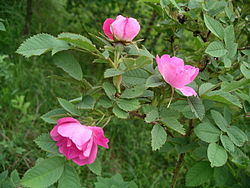This is a list of the native woody plant species of Lithuania. The most common trees, shrubs, subshrubs, and liana species are marked with a star (*). The list contains 98 woody and semi-woody plant species.
Contents
- Trees
- Conifers
- Flowering plant
- Small trees or large shrubs
- Conifers 2
- Flowering plant 2
- Shrubs
- Flowering plant 3
- Small shrubs
- Flowering plant 4
- Subshrubs
- Flowering plant 5
- Liana
- Flowering plant 6
- See also
- References
- External links













